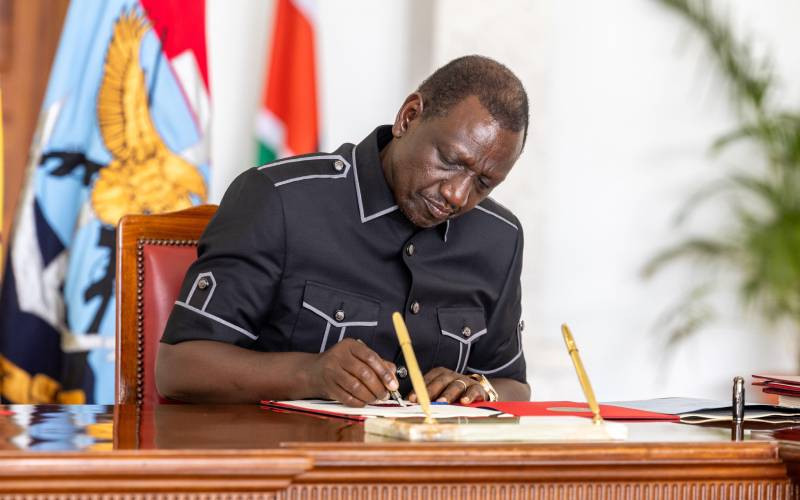NAIROBI, KENYA: The move by the Central Bank of Kenya (CBK) to introduce a new loan pricing tool has not elicited optimism.
Only Standard Chartered Bank has lowered its base lending rate while the rest of the banking industry are yet to make any changes to their loan products.
Analysts argue that the cost credit has not gone down as banks depend on “expensive” customer deposits which they lend out. Some of these deposits attract interest costs to the bank as in the case of fixed deposits.
“We should remember that once a fixed deposit has been placed, the rates cannot change until it matures,” said Dennis Omondi Otieno a business analyst at Commercial Bank of Africa (CBA). “The banks cannot give loans at lower interest and still pay out higher interest in fixed or term deposits.”
DOMESTIC BORROWING
Others argue that the Government’s policy to reduce the cost of credit is counterproductive, as it pushes for lower rates, while at the same time, increasing its domestic borrowing. This puts pressure on the Treasury’s bill rates, which remain high.
As a result, banks still have prime business lending to the Government. They do not see the immediate pressure to lend to households and businesses in the private sector.
“They do not see the need to lower their rates. In simple terms, the Government is competing with local businesses and households in getting credit. This increases the demand and keeps the interest rates high,” said Otieno.
PRICING METHODOLOGY
While Treasury has warned that it will publish names of the most expensive lenders, banks have refused to give in - maintaining their high lending rates. “The new tool was introduced about one and half months ago. Banks already had commitments and letters of offer signed before the Kenya Banks Reference Rate (KBRR) effective date,” said Jesse Timwa, head of credit and legal, ABC Bank.
“The outstanding concerns will be tackled over a transitional period and we expect the new pricing methodology to become fully operational in the next six or so months.” It is still not clear what banks will use to price their loan products. KBRR was introduced by the CBK.
KBRR factors in CBK’s monetary policy direction based on the Central Bank Rate free rate in 91-Day Treasury bill rate. Previously, banks used to price their loans using a Base Rate.
The formula for calculating the Base Rate varied from bank to bank. For further pricing transparency, members of the Kenya Bankers Association voluntarily adopted the Annual Percentage Rate (APR) pricing model. APR is the numerical representation of the total cost of credit.
While bank customers are waiting for interest rates to go down, inflationary pressure is on the rise. Kenya’s inflation crept up to 7.67 per cent in the year to July, from 7.39 per cent in the previous month, the statistics office said.
PURCHASING POWER
Stay informed. Subscribe to our newsletter
The rate was slightly above the central bank’s preferred range of 2.5-7.5 per cent and also just a touch higher than the consensus forecast of 7.63 per cent. “The higher the inflation rate, the more interest rates are likely to rise.
This occurs because lenders will demand higher interest rates as compensation for the decrease in purchasing power of the money they will be repaid in the future. The Banks will demand higher interest rates on loans and pay much less on Fixed Deposits,” said Otieno.
While banks are accused of making super-normal profits, credit is still cheaper in Kenya compared to other regional markets.
“Credit is relatively cheaper in Kenya compared to some other markets in the region; in Kenya there is an entrenched information-sharing frame work which has aided in keeping cost of credit at reasonably affordable rates. For example, credit is more expensive in Uganda,” said Timwa.
Kenyan banks have also been accused of lending at higher rates while paying less of savings, hence maintaining a large spread.
Banks consider cost of funds, risk premium, cost of doing business and profit margins when setting their base lending rates.
LEGAL FEES
“The “total cost of credit” will include the bank interest rate based on the KBRR plus a premium that covers the banks’ cost of funds, margin and risk. Third party costs directly associated with the loan are also covered in the total Cost of credit and these include legal fees, insurance, valuation and government levies,” said Otieno.
He adds that total cost of credit, including estimates for third party costs, should be provided to all loan applicants prior to contract signing.
The higher these costs are, or are likely to be in the future, the higher the commercial banks will set their base lending rates.
INFLATIONARY PRESSURE
Banks are generally anti-risk. They will do anything to cover themselves against forecast inflation, real or perceived future increase of insurance and any other changes that will alter the price of credit.
Once a fixed deposit has been placed, the interest rate payable cannot be altered.
The banks want to be sure that the price in which they get money is lower than the price in which they sell the money.
This is why the interest rates differ so much.
 The Standard Group Plc is a
multi-media organization with investments in media platforms spanning newspaper
print operations, television, radio broadcasting, digital and online services. The
Standard Group is recognized as a leading multi-media house in Kenya with a key
influence in matters of national and international interest.
The Standard Group Plc is a
multi-media organization with investments in media platforms spanning newspaper
print operations, television, radio broadcasting, digital and online services. The
Standard Group is recognized as a leading multi-media house in Kenya with a key
influence in matters of national and international interest.
 The Standard Group Plc is a
multi-media organization with investments in media platforms spanning newspaper
print operations, television, radio broadcasting, digital and online services. The
Standard Group is recognized as a leading multi-media house in Kenya with a key
influence in matters of national and international interest.
The Standard Group Plc is a
multi-media organization with investments in media platforms spanning newspaper
print operations, television, radio broadcasting, digital and online services. The
Standard Group is recognized as a leading multi-media house in Kenya with a key
influence in matters of national and international interest.









